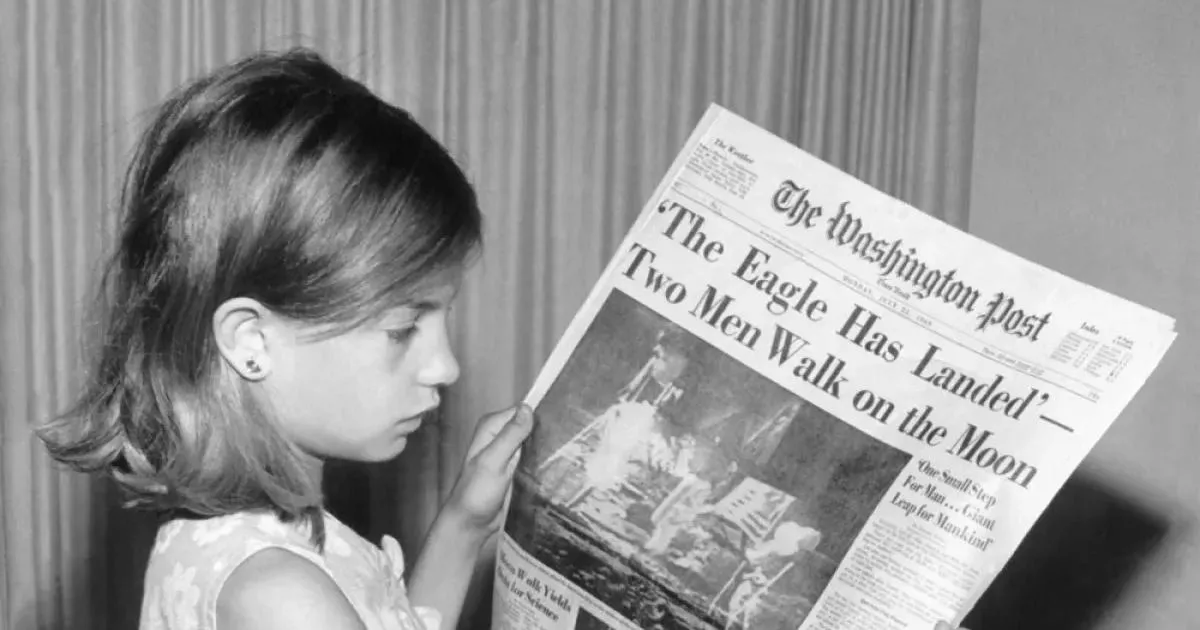News encompasses information about current events disseminated through various media, including word of mouth, print, postal systems, broadcasting, and electronic communication. It can also come from observers and witnesses. The term "hard news" is used to distinguish it from less time-sensitive or in-depth content, often referred to as "soft media."
1902: Britain and the U.S. complete circumtelegraphy
In 1902, Britain and the U.S. completed the circumtelegraphy of the planet with transpacific cables from Canada to Fiji and New Zealand (British Empire), and from the US to Hawaii and the occupied Philippines.
1903: Britain and the U.S. complete circumtelegraphy
In 1903, Britain and the U.S. completed the circumtelegraphy of the planet with transpacific cables from Canada to Fiji and New Zealand (British Empire), and from the US to Hawaii and the occupied Philippines.
1904: James Joyce's Ulysses
In 1904, James Joyce's Ulysses derives from the newspapers of 16 June and represents the newspaper office itself as a vital part of life in Dublin.
September 1918: Lenin instructs the Soviet press to adopt "telegraph style"
In a 20 September 1918 Pravda editorial, Lenin instructed the Soviet press to cut back on their political rambling and produce many short anticapitalist news items in "telegraph style".
1920: Radio expands rapidly across the continent
In 1920, radio expanded rapidly across the continent, from 30 stations to a thousand in the 1930s.
1922: British Broadcasting Company begins transmitting radio news
In 1922, the British Broadcasting Company (BBC) began transmitting radio news from London, dependent entirely, by law, on the British news agencies.
May 1926: BBC radio gains importance during general strike
In May 1926, BBC radio gained importance during the general strike, during which newspapers were closed and the radio served as the only source of news for an uncertain public.
1926: NBC radio network established
In 1926, RCA's Radio Group established its radio network, NBC, in the US. The Paley family founded CBS soon after.
1929: Soviet Union begins international broadcasting
In 1929, The Soviet Union began a major international broadcasting operation in 1929, with stations in German, English and French.
1931: Chinese Communist Party creates the Red China News Agency
In 1931, The Chinese Communist Party created its news agency, the Red China News Agency, whose primary responsibilities were the Red China newspaper and the internal Reference News.
1933: Radio broadcasters negotiate agreement with the press
In 1933, radio broadcasters in the United States negotiated an arrangement with the press, agreeing to use only news from the Press–Radio Bureau and eschew advertising, however this agreement soon collapsed.
1937: British government sets up BBC radio services
In 1937, the British government used BBC radio as a diplomatic tool, setting up Arabic, Spanish and Portuguese services.
1937: Red China News Agency renamed Xinhua News Agency
In 1937, the Chinese Communist Party renamed the Red China News Agency to Xinhua News Agency, which later became the official news agency of the People's Republic of China in 1949.
1939: Radio considered more accurate than newspapers
By 1939, 58% of Americans surveyed by Fortune considered radio news more accurate than newspapers, and 70% chose radio as their main news source.
1942: U.S. sets up Office of War Information
In 1942, the U.S. set up its Office of War Information which sent programming across South America, the Middle East, and East Asia.
1945: New York newspaper strike
In 1945, during the New York newspaper strike, New Yorkers exhibited a virtual addiction to news, describing themselves as "lost", "nervous", "isolated", and "suffering" due to the withdrawal.
1949: Xinhua News Agency becomes official news agency
In 1949, the Xinhua News Agency became the official news agency of the People's Republic of China, after being renamed from the Red China News Agency in 1937.
1955: Voice of America surpasses British radio network
By 1955, Voice of America programs, produced by the United States Information Agency, surpassed Britain's radio network in scope.
1964: Inter Press Service Founded
In 1964, the Inter Press Service was founded. It has served as an intermediary for Third World press agencies.
1969: Moon landing
In 1969, the Moon landing was a source of the country's most important news in the United States.
1975: Experimental satellite television system implemented in India
In India, from 1975 to 1976, the United States Agency for International Development, the National Aeronautics and Space Administration, and UNESCO implemented an experimental satellite television system, called the Satellite Instructional Television Experiment, with assistance from the Indian Space Research Organisation, and All India Radio.
1976: Experimental satellite television system implemented in India
In India, from 1975 to 1976, the United States Agency for International Development, the National Aeronautics and Space Administration, and UNESCO implemented an experimental satellite television system, called the Satellite Instructional Television Experiment, with assistance from the Indian Space Research Organisation, and All India Radio.
1979: Capture of American hostages in Iran
In 1979, the capture of American hostages in Iran dominated months of news coverage in the western media, gained the status of a "crisis", and influenced a presidential election.
1980: Soviet Union surpasses the United States in broadcasting
Around 1980, the Soviet Union surpassed the United States for a time as the world's top broadcaster.
1980: CNN inaugurated
In 1980, Ted Turner's creation of the Cable News Network (CNN) inaugurated a new era of 24-hour satellite news broadcasting.
1980: MacBride report calls for interdependent global news system
In 1980, the MacBride report, "Many Voices, One World", called for an interdependent global news system with more participation from different governments. To this end, also, UNESCO formed the Non-Aligned News Agencies Pool.
1981: Bloomberg LP founded
In 1981, Bloomberg LP, a private company founded by Michael Bloomberg, was created to make rapid advances with computerized stock market reporting updated in real time.
1986: Space Shuttle Challenger explosion
In 1986, the Space Shuttle Challenger explosion was a source of the country's most important news in the United States.
1987: U.S. media reports on a riot in the Dominican Republic
In 1987, the U.S. media reported on a riot in the Dominican Republic. This was the first major news item regarding that country in years, and the resulting decline in tourism lasted for years, causing a noticeable effect on the economy.
1989: Tiananmen Square Incident
In 1989, local and global communications media-enabled instant exposure to and discussion of the Chinese government's actions in Tiananmen Square. The news about Tiananmen Square travelled over a fax machine, telephone, newspaper, radio, and television, and continued to travel even after the government imposed new restrictions on local telecommunications.
1990: News story about Iraqi soldiers taking babies out of incubators
In 1990, a news story emerged about Iraqi soldiers taking "babies out of incubators" in Kuwaiti hospitals, demonstrating how public relations can dovetail with state objectives.
1991: BBC introduces BBC World Service Television
In 1991, the BBC introduced a competitor to CNN, called BBC World Service Television.
1992: Gulf War Coverage
The United States waged the 1991–1992 Gulf War with the assistance of nonstop media coverage.
1994: Netscape browser release
In 1994, the early internet became available to a wider public with the release of the Netscape browser. An earthquake in California was one of the first big stories to be reported online in real time.
April 1995: Oklahoma City bombing
On the day of the Oklahoma City bombing in April 1995, people flocked to newsgroups and chatrooms to discuss the situation and share information. The Oklahoma City Daily posted news to its site within hours.
April 1996: Al Jazeera emerges
In April 1996, the Qatar-owned broadcaster Al Jazeera emerged as a powerful alternative to the Western media.
1997: Death of Princess Diana
In 1997, the death of Princess Diana was a source of the country's most important news in the United States.
2000: Intervention of the Supreme Court in the presidential election
In 2000, the intervention of the Supreme Court in the presidential election was a source of the country's most important news in the United States.
2001: Television coverage of the destruction of the World Trade Center
In 2001, television coverage of the destruction of the World Trade Center, which repeated the same footage over and over, led to symptoms of psychological trauma experienced across the United States.
2001: September 11 attacks
In 2001, the September 11 attacks was a source of the country's most important news in the United States.
2002: Xinhua news agency
In 2002, Xinhua news agency had 16,969 subscribers, including 93% of Chinese newspapers. It operates 123 foreign bureaus and produces 300 news stories each day.
2003: World Summit on the Information Society
In 2003 and 2005, issues relating to global information flow were revisited in light of the internet at the World Summit on the Information Society, a conference which emphasized the role of civil society and the private sector in information society governance.
2005: World Summit on the Information Society
In 2003 and 2005, issues relating to global information flow were revisited in light of the internet at the World Summit on the Information Society, a conference which emphasized the role of civil society and the private sector in information society governance.
2009: Journalists reproduce fictional quotation from Wikipedia
In 2009, a number of journalists were embarrassed after all reproducing a fictional quotation, originating from Wikipedia.
2010: Google News redesigned front page
In 2010, Google News redesigned its front page with automatic geotargeting, which generated a selection of local news items for every viewer.
2011: Thomson Reuters revenue
In 2011, Thomson Reuters employed more than 55,000 people in 100 countries, and posted an annual revenue of $12.9 billion.
2012: Twitter statement on news discovery
In 2012, Twitter stated that its platform allowed users to discover news as it's happening, learn more about topics that are important to them, and get the inside scoop in real time.
2013: Anchorman 2 film release
In 2013, the film Anchorman 2 was released. The release of the 2013 film Anchorman 2 gained widespread attention following the film's release.
February 2018: TechCrunch journalist Josh Continue stated Facebook "stole the news business"
In February 2018, TechCrunch journalist Josh Continue stated that Facebook "stole the news business" and used sponsorship to make many news publishers its "ghostwriters."
January 2019: Mark Zuckerberg announced he will spend $300 million in local news buys
In January 2019, Facebook founder Mark Zuckerberg announced that he will spend $300 million in local news buys over a three-year period.
Mentioned in this timeline

Mark Zuckerberg is an American businessman and programmer best known...
Facebook is a social media and networking service created in...

Michael Bloomberg is an American entrepreneur politician and philanthropist He...

Google LLC is a multinational technology company specializing in online...
California is a U S state on the Pacific Coast...

The stock market serves as a platform where buyers and...
Trending
28 days ago Titanic Passenger's Gold Pocket Watch Anticipated to Break Auction Records, Selling for Millions.

27 days ago Ja'Marr Chase Suspended One Game: Spitting Incident Sparks Controversy, Appeal Pending
2 months ago Chris Witaske from 'The Bear' to be Grand Marshal in St. Charles Parade.

6 months ago Aaron Rodgers' Marriage Sparks Family Drama; Quarterback Finds Solace with Steelers

2 months ago Donovan Clingan impresses in Preseason; Predicted to achieve Double-Double average this season.

7 months ago Clowney Released by Panthers, Potential Trade to 49ers?
Popular

Candace Owens is an American conservative political commentator and author...

Ilhan Omar is an American politician currently serving as the...

XXXTentacion born Jahseh Dwayne Ricardo Onfroy was a controversial yet...

Oprah Winfrey an American talk show host television producer actress...

Tom Cotton is an American politician and Army veteran currently...
Matt and Ross Duffer known as the Duffer Brothers are...

